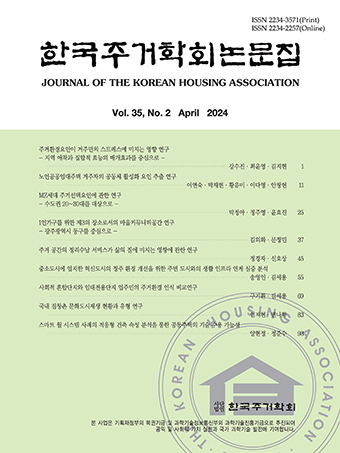Research Article
Bae, E. S., Son, J. H., Park, H. K., & Song, Y. J. (2017). The Impact of Community Attachment on Community Satisfaction - Focused on the Income Level. Social Science Reviews, 24(1), 137-156.
10.46415/jss.2017.03.24.1.137Bolger, N., DeLongis, A., Kessler, R. C., & Schilling, E. A. (1989). Effects of daily stress on negative mood. Journal of personality and social psychology, 57(5), 808.
10.1037/0022-3514.57.5.8082810026Bower, G. H. (1961). A contrast effect in differential conditioning. Journal of Experimental Psychology, 62(2), 196.
10.1037/h0048109Brown, G. W., & Harris, T. (1978). Social origins of depression: a reply. Psychological medicine, 8(4), 577-588.
10.1017/S0033291700018791724871Casakin, H., & Reizer, A. (2017). Place Attachment, residential satisfaction, and life satisfaction: Traditional and renewed kibbutz. Journal of Human Behavior in the Social Environment, 27(7), 639-655.
10.1080/10911359.2017.1317313Choi, B. S., & Park, J. A. (2012). An Effect of Housing Environment on Depression and Self-esteem in Analyzing the 4th Wave of Korea Welfare Panel Study Data in 2009. Journal of the Korean Housing Association, 23(5), 75-86.
10.6107/JKHA.2012.23.5.075Choi, H. Y., & Jun, H. J. (2017). The Relationship between Residential Mobility and Residential Satisfaction in the Seoul Metropolitan Area. Journal of The Korean Urban Management Association, 30(1), 163-180.
10.36700/KRUMA.2017.03.30.1.163Choi, Y. J., & Matz-Costa, C. (2018). Perceived neighborhood safety, social cohesion, and psychological health of older adults. The Gerontologist, 58(1), 196-206.
10.1093/geront/gny02129718249Cicognani, E., Pietrantoni, L., Palestini, L., & Prati, G. (2009). Emergency workers' quality of life: The protective role of sense of community, efficacy beliefs and coping strategies. Social Indicators Research, 94(3), 449.
10.1007/s11205-009-9441-xCutrona, C. E., Russell, D. W., Hessling, R. M., Brown, P. A., & Murry, V. (2000). Direct and moderating effects of community context on the psychological well-being of African American women. Journal of personality and social psychology, 79(6), 1088.
10.1037/0022-3514.79.6.108811138756Dallago, L., Perkins, D. D., Santinello, M., Boyce, W., Molcho, M., & Morgan, A. (2009). Adolescent place Attachment, social capital, and perceived safety: A comparison of 13 countries. American journal of community psychology, 44(1-2), 148.
10.1007/s10464-009-9250-z19533329Eom, Y. H., & Eom, K. H. (2017). The Influence of Place Attachment on the Happiness of Residents : Focus on Seoul. The Korea local administration review, 31(2), 145-169.
Friesinger, J. G., Haugland, S. H., & Vederhus, J. K. (2022). The significance of the social and material environment to place Attachment and quality of life: findings from a large population-based health survey. Health and Quality of Life Outcomes, 20(1), 1-9.
10.1186/s12955-022-02045-236088453PMC9463864Heo, J. H., Cho, Y. T., & Kwon, S. M. (2010). The Effects of Socioeconomic Deprivations on Health. Korean Journal of Sociology, 44(2), 93-120.
Herrick, H., & Di Bona, V. (2013). The association of housing stress, health, chronic disease and health care resources: Results from the 2011 North Carolina BRFSS Survey. Department of Health and Human Services, State Center for Health Statistics.
Hwang, K. H., Kim, M. J., Park, J. M., Hong, S. W., Seo, Y. S., & Kim, D. H. (2020). The Effect of Housing Unaffordability on the Incidence of Depression in Korean Adults: Focusing on Korean Longitudinal Study of Aging. Korean Journal of Family Practice, 10(4), 307-313.
10.21215/kjfp.2020.10.4.307Hyun, A. N., & Kim, Y. M. (2014). The Role of Collevtive Efficacy and Parental Bonding in Victim-defending Behavior: The Mediating Effect of Empathy. Korean Journal of youth welfare, 16(1), 129-153.
Jeon, H. J., Kim, H. Y., & Jeon, K. K. (2019). The Effects of Objective Characteristics and Subjective Evaluation of Community on Depression of Adults - The Case of Seoul City -. Journal of community welfare, 71, 1-39.
10.15300/jcw.2019.71.4.1Jo, M. J., & Lim, E. (2016). The effect of income-mix on place Attachment as civic pride in Seoul : Using the Seoul Survey. Journal of the Korean Regional Science Association, 32(3), 3-15.
Jung, S. H., & Ko, S. C. (2011). Spatial Impacts of Industrial Complex Development on Residential Amenities in Neighboring Community: the Case of Siwha New Town in Korea. Modern Society and Public Administration, 21(1), 49-69.
Kang, K. W., Kim, H. J., Kwon, G. Y., & Jung, M. S. (2009). Effect of Residential Environment on the Health Status in Apartment Inhabitants. Journal of Agricultural Medicine & Community Health, 34(3), 279-290.
10.5393/JAMCH.2009.34.3.279Kang, S. J., & Seo, W. S. (2020). The Impact of Living Expenses of Low-Income Households on Mental Health by Housing Tenure Type. Housing Studies, 28(4), 63-85.
10.24957/hsr.2020.28.4.63Kim, C. D., Oh, K. O., & Kim, T. S. (2008). A Comparative Study on the Stress, Coping Method, and Mental Health of the Nursing College Students in Korea and China. Journal of Korean Academy of Psychiatric Mental Health Nursing, 17(1), 75-84.
Kim, S. Y., Kim, S. L., & Lee, J. S. (2013). The Effect on Housing on Health. Health and Social Science, 34, 109-133.
Kobasa, S. C., Maddi, S. R., & Courington, S. (1981). Personality and constitution as mediators in the stress-illness relationship. Journal of health and social behavior, 368-378.
10.2307/21366787320474Kwon, S. Y., & Song, M. G. (2017). The Effects of Community Attachment and Civic Consciousness on Pro-Environmental Behavioral Intention - Pyeongtaek Case Study -. Journal of Environmental Policy and Administration, 25(3), 195~219
10.15301/jepa.2017.25.3.195Lev-Wiesel, R. (2003). Indicators constituting the construct of 'perceived community cohesion'. Community development journal, 38(4), 332-343.
10.1093/cdj/38.4.332Lewicka, M. (2011). Place Attachment: How far have we come in the last 40 years?. Journal of environmental psychology, 31(3), 207-230.
10.1016/j.jenvp.2010.10.001Lim, B. H., Lee, K. H., & Ji, N. S. (2015). A Comparative Study on the Residential Environment Satisfaction and the Influential Factors on the Residential Improvement Project District and the Housing Redevelopment Project District in Daejeon Metropolitan Area. Journal of The Korean Urban Management Association, 28(1), 33-51.
Lim, H. M., & Kim, J. B. (2014). Reciprocal Relationships between Collective Efficacy and Health. Health and Social Welfare Review, 34(4), 441-466.
10.15709/hswr.2014.34.4.441Lim, J. H., & Kim, J. W. (2020). The Moderating Roles of Social Relationships and Activity Participation in the Effect of Socioeconomic Status on the Risk of Suicidal Ideation: Comparison of Different Patterns across Age Groups and Sex. Survey research, 21(1), 117-149.
10.20997/SR.21.1.5Lim, S. H., & Jang, H. S. (2017). A Study on the Impact of Housing Environment of Residents Health - The Case of Incidence Rate of Environmental Disease -. Journal of The Residential Environment Institute of Korea, 15(2), 101-117.
10.22313/reik.2017.15.2.101Marcheschi, E., Laike, T., Brunt, D., Hansson, L., & Johansson, M. (2015). Quality of life and place Attachment among people with severe mental illness. Journal of Environmental Psychology, 41, 145-154.
10.1016/j.jenvp.2014.12.003McCool, S. F., & Martin, S. R. (1994). Community Attachment and attitudes toward tourism development. Journal of Travel research, 32(3), 29-34.
10.1177/004728759403200305Park, J. H., & Park, H. J. (2012). The Effect of Collective Efficacy in Local Community on Environmental Behavior. ECO, 16(2), 147-180.
Park, K. O., & Ryu, J. H. (2015). Empirical Study Among Community Attachment, Community Satisfaction and Attitude Toward Regional Tourism Development According to the Moderating Effect of Residental Area - The Case of Heaundea-gu and Gijang-goon -. Journal of Hospitality and Tourism Studies, 17(3), 22-38.
Prezza, M., Amici, M., Roberti, T., & Tedeschi, G. (2001). Sense of community referred to the whole town: Its relations with neighboring, loneliness, life satisfaction, and area of residence. Journal of community psychology, 29(1), 29-52.
10.1002/1520-6629(200101)29:1<29::AID-JCOP3>3.0.CO;2-CRamkissoon, H., Smith, L. D. G., & Weiler, B. (2013). Relationships between place Attachment, place satisfaction and pro-environmental behaviour in an Australian national park. Journal of Sustainable tourism, 21(3), 434-457.
10.1080/09669582.2012.708042Rho, B. I., & Kwak, H. K. (2005). A Study on the Effect of Neighborhood-Level Contextual Characteristics on Mental Health of Community Residents. Health and Social Science, 17(1), 5-31.
Ross, C. E., & Jang, S. J. (2000). Neighborhood disorder, fear, and mistrust: The buffering role of social ties with neighbors. American journal of community psychology, 28(4), 401-420.
10.1023/A:100513771333210965384Ross, C. E., & Mirowsky, J. (2009). Neighborhood disorder, subjective alienation, and distress. Journal of health and social behavior, 50(1), 49-64.
10.1177/00221465090500010419413134Roster, C., Ferrari, J., & M. P. Jurkat(2016), The dark side of home: Assessing possession 'clutter' on subjective wellbeing. Journal of Environmental Psychology, 46, 32-41
10.1016/j.jenvp.2016.03.003Roussi, P., Rapti, F., & Kiosseoglou, G. (2006). Coping and psychological sense of community: An exploratory study of urban and rural areas in Greece. Anxiety, stress, and coping, 19(2), 161-173.
10.1080/10615800600593304Sampson, R. J., Raudenbush, S. W., & Earls, F. (1997). Neighborhoods and violent crime: A multilevel study of collective efficacy. Science, 277(5328), 918-924.
10.1126/science.277.5328.9189252316Ullman, J. B., & Bentler, P. M. (2003). Structural equation modeling. Handbook of psychology, 607-634.
10.1002/0471264385.wei0224Wang, Y. J., Oh, I. S., & Ryu, S. H. (2021). The effect of COVID-19 stress on mental health and covitality among chinese international students: Focusing on mediating effect of acculturative stress. Journal of educational studies, 52(3), 169-194.
10.15854/jes.2021.09.52.3.169Wen, M., Fan, J., Jin, L., & Wang, G. (2010). Neighborhood effects on health among migrants and natives in Shanghai, China. Health & Place, 16(3), 452-460.
10.1016/j.healthplace.2009.12.00120060767Yoo, S. H., Kim, J. H., & Lim, J. (2022). A study on the effect of poor housing on self-esteem, depression: Focusing on comparison of the people with and without disabilities. Korean journal of health education and promotion, 39(5), 15-28.
10.14367/kjhep.2022.39.5.15Yoon, W. S. (2014). Testing the impacts of the perceived community social disorganization on depressive mood: Focusing on the role of disorder, social cohesion, and informal social control. Korean Police Studies Review, 13(1), 117-146.
- Publisher :The Korean Housing Association
- Publisher(Ko) :한국주거학회
- Journal Title :Journal of the Korean Housing Association
- Journal Title(Ko) :한국주거학회논문집
- Volume : 35
- No :2
- Pages :001-010
- Received Date : 2024-01-26
- Revised Date : 2024-03-19
- Accepted Date : 2024-03-19
- DOI :https://doi.org/10.6107/JKHA.2024.35.2.001



 Journal of the Korean Housing Association
Journal of the Korean Housing Association






